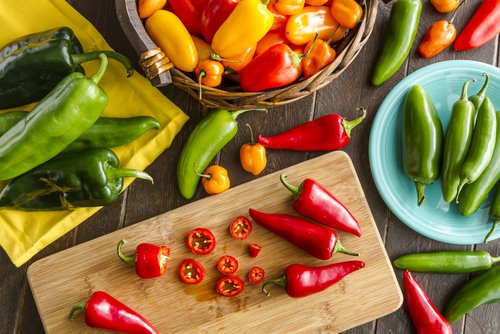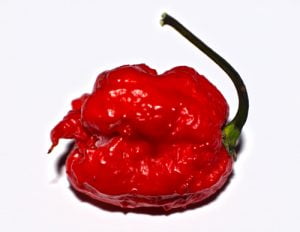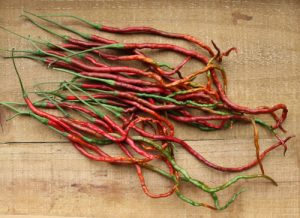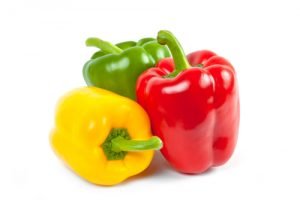
What is a Capsicum?
Capsicum is a genus of plants that are derived from the nightshade family (Solanaceae), as are potatoes and tomatoes. The capsicum originated from the Americas but they are now grown worldwide. They produce a variety of fruits, that even in the English speaking world, have different names in different countries. The small, cone-shaped, fiery tasting fruits (Capsicum Fretescens), are normally referred to as “chillies” in the UK. However, they are also known as chilli pepper, chile, or chile pepper, in other countries.
The larger, bell or cone-shaped, mild-tasting fruits (Capsicum Annum) are called ‘bell peppers’ in the USA. In New Zealand and Australia, they are called ‘capsicums’, and normally just ‘peppers’ in the UK. In other countries, they may also be referred to as ‘paprika’, although this can also refer to the powdered spice made from various capsicum fruit. While red, green and yellow are the most popular colours, peppers can come in a great variety of shades.

Carolina Reaper – the world’s hottest chilli
The substance that gives capsicums their intensity is capsaicin and its related compounds, known as capsaicinoids. The intensity of capsicum is measured on the Scoville Scale, named after Wilbur Scoville, an American pharmacist, who invented the test in 1912. Basically, the more capsaicin present in the fruit, the hotter the taste. The test measures the heat of the fruit in terms of SHU’s, and while the bell pepper scores 0, the world’s current hottest chilli, the Carolina Reaper, averages a score of more than 1.6 million.
Growing Chillies and Peppers
While chillies and peppers can both be grown indoors, in a greenhouse or outdoors in the UK, the latter option is the least favourable environment. Basically, the plants need rich soil and warmth, so they can be best grown in pots on a sunny windowsill or in a warm greenhouse, but alternatively, in a bright, sheltered patch, somewhere in the garden.
- The soil bed in the garden should be dug to at least 12’’ (300 mm) deep and enriched with old manure. For greenhouse plants, the potting mixture should be two parts of rich loamy soil, and one-part old manure, with a little sharp sand, added, for good measure.
- Sow seeds in February or March if planted in a heated greenhouse. Sow 3 or 4 seeds as far wide as possible in a 4” pot. When the seedlings reach about 1.5” (40 mm) high, transfer them to their own pot.
- Seedlings that are to be eventually planted outside will need to be hardened-up, by gradually exposing them to outdoor conditions. Those remaining inside or in the greenhouse should be transferred to a 6” pot in due course and staked.
- Best to plant out at the foot of a south-facing wall or fence in the warmest and sunniest position possible in the garden. Each plant should be staked and be at 12” spacing but don’t plant before the beginning of June. Soils must be well-drained, with an optimum pH of 5.0–6.0, and have low salinity.
- Watering should be done frequently, with enough water to soak the ground down several inches. Cover soil surface around the plants with wet hop manure or alternatively feed them with a general-purpose artificial fertiliser mixture.
Both chilli and capsicum plants produce white flowers during the summer, which will be followed by the growth of pods/fruit. Both chilli and pepper seeds can be sown indoors between February and April, and harvested between July and October. If capsicums are to be pickled, then they are best picked just before they begin to colour. Pick chillies when they are fully coloured.
Popular types of Chilli
Longhorn – is a cayenne type of chilli, that produces long curled fruit, with a pungent, sweet taste. They can be readily grown in containers as long as they have support.
Fuego – is a hybrid variety of chilli that offers good resistance to cold, so a good choice for growing outdoors. Produces a fiery scarlet fruit that grows around 6” (150 mm) in length.

Longhorn is a popular type of chilli pepper
Popular types of Pepper
Giant Bell – is a traditional ‘bell’ pepper that produces a good-sized fruit. They turn from red to green but can be eaten at any time of their development, having a mild, sweet taste.
King of the North – is a thick-walled pepper that should produce a prolific crop. They will normally do equally well in a sheltered position outside as in a cool greenhouse.

Bell Peppers can come in many colours
NB: Growing information relates to seasonal conditions in the UK.
If you’ve enjoyed reading this article, why not click on the link to Hobbies and Pastimes, to see if there’s anything else that takes your interest?





